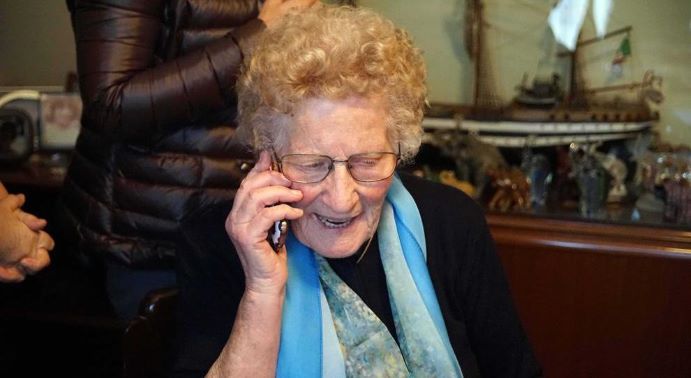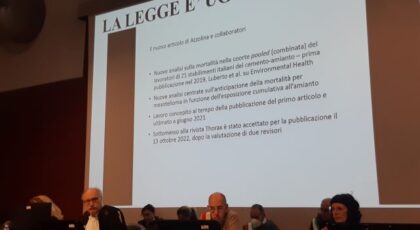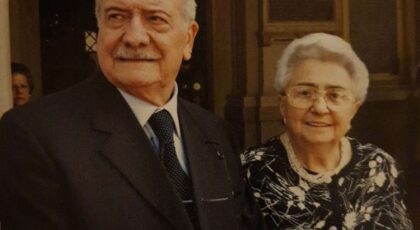SILVANA MOSSANO
«Tanti auguri, Romana». Giovedì 3 marzo Romana Blasotti Pavesi, che è stata storica, combattiva presidente dell’Afeva, icona dell’ardua battaglia contro l’amianto e conosciuta in tutto il mondo finanche in Amazzonia, ha compiuto 93 anni. A causa dell’amianto ha perso il marito Mario, operaio all’Eternit, la figlia Maria Rosa, poco più che cinquantenne, la sorella Libera e nipoti.
Al telefono: «Romana, buon compleanno!».
Attimo di silenzio, poi: «Ricordami bene: che giorno è oggi?» domanda con la voce stentorea e sicura di sempre, che abbiamo ascoltato anche in momenti particolarmente accesi.
«E’ il 3 marzo».
«Ah, allora sì, è proprio il mio compleanno». Ha sempre avuto cura per la precisione delle parole e dei fatti.
«Come stai, Romana?».
«Molto bene, grazie, sto molto bene». Il suo stile: severa e garbata, asciutta e gentile.
Buon compleanno, Romana, buon compleanno.

* * *
E giovedì 3 marzo si è svolta a Torino la prima parte della discussione del processo d’appello in cui Stephan Schmidheiny è imputato di omicidio colposo per due vittime dell’amianto a Cavagnolo, dove fino al 1982 aveva operato lo stabilimento Saca di proprietà di Eternit spa italiana, nell’ambito della multinazionale di cui l’imprenditore svizzero è stato gestore.
La Corte d’Appello è presieduta da Flavia Nasi, già presente nel collegio di Corte d’Appello presieduto da Alberto Oggé che, nel 2012, aveva condannato Schmidheiny a 18 anni per disastro ambientale doloso permanente nel maxiprocesso Eternit 1 (poi dichiarato prescritto dalla Cassazione nel 2014).
Ora, nel processo Eternit Bis, in particolare nel «filone Cavagnolo», il reato contestato è omicidio colposo, diversamente dai filoni in Corte d’Assise a Novara (per 392 morti casalesi e monferrini) e a Napoli (per 8 morti di Bagnoli) in cui l’imputato è chiamato a rispondere di omicidio doloso (volontario).
Al processo d’appello torinese per Cavagnolo, dunque, il sostituto procuratore della procura generale di Corte d’Appello Carlo Maria Pellicano ha concluso la requisitoria insistendo sulla conferma della condanna già emessa in primo grado a 4 anni di reclusione.
La sentenza era stata pronunciata dal giudice monocratico Cristiano Trevisan a maggio 2019: Schmidheiny era stato riconosciuto colpevole della morte per amianto di Giulio Testore e di Rita Rondano. In particolare, Testore aveva lavorato alla Saca-Eternit dal 1955 al 1982 (l’avvocato Laura Mara, patrono di parte civile per Medicina Democratica, ha ricordato che l’operaio era stato impiegato nei reparti di maggiore esposizione), ed era morto nel 2008 a 72 anni. Il consulente della difesa, Canzio Romano, aveva ipotizzato che il decesso dell’operaio fosse da ricondursi al vizio del fumo; fu appurato, però, che Testore fumava un paio di sigarette al giorno e un consulente della procura aveva affermato che chi fuma una o due sigarette al giorno è da ritenersi «non fumatore».
Rondano non era stata operaia alla Saca, ma aveva abitato a qualche centinaio di metri dai magazzini della fabbrica e aveva lavorato per decenni come contadina nella campagna attigua; era morta di mesotelioma nel 2012, a 72 anni.
Il pm della procura generale Pellicano ha, ora, insistito che venga confermata la condanna, ribadendo la «colpa cosciente» attribuita all’imputato, di cui, come ha rilevato il sostituto procuratore, si hanno riscontri, ad esempio, nella convocazione del convegno di Neuss nel 1976 (in cui Schmidheiny stesso informò i suoi stretti collaboratori della gravissima pericolosità della fibra di amianto), nella successiva emanazione del Manuale Auls 76 (contenente indicazioni precise cui dovevano attenersi i dirigenti chiamati via via a rispondere a interrogativi posti dai lavoratori, dai sindacati, dagli amministratori locali, dai giornalisti, dai cittadini), nell’impiego e nel ruolo dello scienziato Robock e in altre iniziative di disinformazione (più avanti il Manuale Bellodi).
Nell’udienza di giovedì, dopo il pm, sono intervenuti i legali di parte civile, tra cui Laura Mara, Laura D’Amico, Mariagrazia Napoli. Altri hanno depositato memorie scritte.
La prossima udienza si terrà il 18 maggio: parlerà ancora un legale di parte civile e poi toccherà ai difensori storici di Schmidheiny, gli avvocati Astolfo Di Amato e Guido Carlo Alleva, argomentare le arringhe.
A maggio 2019, subito dopo la sentenza di primo grado a 4 anni (il pm Gianfranco Colace ne aveva chiesti 7) in un comunicato i difensori avevano sottolineato che Schmidheiny è «il capro espiatorio dell’inerzia dello Stato italiano», che «per decenni» non regolamentò il trattamento e l’uso dell’amianto. Sempre secondo le argomentazioni della difesa, alla multinazionale Eternit si impiegavano standard di sicurezza «nettamente superiori rispetto a quelle in vigore in Italia e nelle aziende concorrenti».
Non abbastanza, viene da dire; non abbastanza nonostante sia provato che Schmidheiny ben conoscesse la pericolosità mortale della fibra; non abbastanza visto che ci sono stati (e ci sono) così tanti malati e morti nelle località contaminate dalla produzione degli stabilimenti Eternit, malati e morti sia che abbiano lavorato in fabbrica sia che in quelle città e paesi siano semplicemente vissuti.
Translation by Vicky Franzinetti
SILVANA MOSSANO
“Happy Birthday, Romana.
” On Thursday, March 3, Romana Blasotti Pavesi, who was the first and strong president of victims’ association of Casale (AFEVA), an icon of the battle against asbestos and known throughout the world, even in the Amazon, turned 93. She lost her husband Mario, an Eternit worker, her daughter Maria Rosa, just over 50 fifty, her sister Libera and grandchildren to asbestos.
I phone her to wish her a happy birthday! A moment’s silence, then: “Remind me: what day is today?” she replies with the clear and confident voice of always, which we heard even in particularly heated moments.
“It is March the 3rd .”
“Ah, then yes, it is indeed my birthday.” She always cared about speaking accurately and acting consequently.
“How are you, Romana?”
“Very well, thank you, I’m very well.” Her style: stern and a few polite words. Happy birthday, Romana, happy birthday.
* * *
And on Thursday, March 3, in Turin the first hearing of the Appeal Trial where Stephan Schmidheiny is accused of manslaughter for two victims of asbestos who worked in Cavagnolo, where until 1982 the Saca plant owned by Italian Eternit spa, part of the multinational of which the Swiss entrepreneur was manager was operational.
The Turin Court of Appeal is presided over by Judge Flavia Nasi, who was a Judge in the Court of Appeal presided by Dr Alberto Oggé which, in 2012, sentenced Schmidheiny to 18 years for permanent wilful environmental disaster in the Eternit 1 maxi-trial (which in 2014 the Court of Cassation subsequently quashed because of the statute of limitations).
Unlike the cases being heard in the Novara Court of Assizes (for 392 deaths in Casale and in the Monferrato District) and in Naples (for 8 deaths in Bagnoli) where the defendant is called to answer the count of voluntary murder (omicidio volontario) for the “Cavagnolo cases “, the charge is (voluntary) manslaughter (omicidio doloso volontario).
At the Turin Appeal trial for Cavagnolo, therefore, Dr Carlo Maria Pellicano, Prosecutor of the General Prosecutor’s Office of the Court of Appeal, gave a closing speech by insisting on the confirmation of the sentence already handed down by the Court of in the first instance (the trial court), that is 4 years imprisonment.
The first verdict was handed down by Judge Cristiano Trevisan in May 2019 at the Turin Courts: Schmidheiny had been found guilty of the asbestos-related deaths of Giulio Testore and Rita Rondano. In particular, Testore had worked at Saca-Eternit from 1955 to 1982. Lawyer Laura Mara, for Medicina Democratica (Democratic medicine an association standing in the case as partie civile), recalled that the worker had been employed in the workshops where there was exposure to asbestos, and had died in 2008 at the age of 72. The defense expert witness, Prof Canzio Romano, had suggested that the worker’s death was due to smoking. However, it was proved that Testore smoked a couple of cigarettes a day and a prosecutor’s expert witness had stated that anyone who smoked one or two cigarettes a day was classed as a “non-smoker”.
Rondano had not been a worker at Saca, but lived a few hundred meters from the plant warehouses and had worked for decades as a farmer in the fields nearby; she died of mesothelioma in 2012, at the age of 72.
Prosecutor Pellicano insisted that the sentence should be confirmed, reaffirming the defendant’s conscious guilt. Dr Pellicano stated that evidence can be found , for example, in the convocation of the Neuss conference in 1976 where Schmidheiny himself informed his close associates of the seriousness of the danger of asbestos fibers, in the subsequent issue of the Auls 76 Manual containing precise answers to be given by the managers called upon to answer questions posed by workers, trade unions, local administrators, journalists and citizens, and in the employment and role of the scientist Dr Robock and in other disinformation initiatives (later known as the Bellodi Manual).
In Thursday’s hearing, the lawyers for the plaintiffs, including Laura Mara, Laura D’Amico, and Mariagrazia Napoli spoke after the Public Prosecutor. Other lawyers filed written briefs.
The next hearing will be held on May 18: a plaintiff’s attorney will speak again and then it will be the turn of Schmidheiny’s traditional defense, attorneys Astolfo Di Amato and Guido Carlo Alleva, to give their closing speeches.
In May 2019, immediately after the first-degree sentence to 4 years – PP Gianfranco Colace had asked for 7 years – in a statement, the defence had stated that Schmidheiny is “the scapegoat of the inertia of the Italian State“, that “for decades” failed to regulate the processing and use of asbestos. According to them. the multinational Eternit used safety standards significantly higher than those in force in Italy and in competing companies.
The first thought that comes to my mind is Not enough; not enough and it has been proven that Schmidheiny was well aware of the deadly danger of the fiber; not enough considering that there have been (and there are) so many sick and dead people in the areas contaminated by the production of Eternit plants, sick and dead whether they worked in the factory or simply lived in those cities and towns.






Auguri Romana. Illumina il nostro cammino verso la Giustizia.
Auguri Romana, esempio di forza e tenacia per tutti noi.! Hai trasformato la tua sofferenza in lotta perché altri non debbano soffrire più
Auguri Romana, donna esempio per tutti noi
Happy birthday wishes for Romana from the Netherlands!
One wouldn’t let a blind man walk towards the edge of a cliff and disregard the situation, just because the legislator is lagging far behind. Equally, it is ridiculous to possess specific, early knowledge regarding asbestos dangers and then to do nothing, knowing others are exposed to serious harm, meanwhile hiding behind the skirts of the legislator. The knowledge of a danger creates an obligation to act accordingly. That’s what I teach to liability lawyers and I stand by that.
Yvonne
Our congts from Brazil to the dearest warrior Romana for her birthday.
Fernanda
Wishing Romana a magical and fabulous birthday! She inspires and amazes me — the unstoppable Romana is loved around the world.
Romana, eat cake all week!
Love
Linda
Auguri a Romana dal Canada
Alec